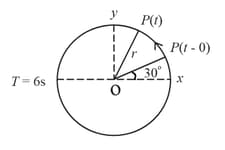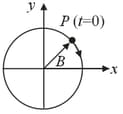Explain the relationship between uniform circular motion and SHM.
Important Questions on Oscillations
For particle revolving round the centre with radius of circular path and regular velocity , as shown in below figure, the projection of on the -axis at time is

Figure shows the circular motion of a particle. The radius of the circle, the period, sense of revolution and the initial position are indicated on the figure. The simple harmonic motion of the -projection of the radius vector of the rotating particle is :
(Given, time period of revolution

A particle is moving in a uniform circular motion on a horizontal surface. Particle's position and velocity at time are shown in the figure in the coordinate system. Which of the indicated variable on the vertical axis is/are correctly matched by the graph(s) shown alongside for particle's motion?

A particle is moving in a uniform circular motion on a horizontal surface. Particle position and velocity at time are shown in the figure in the coordinate system. Which of the indicated variable on the vertical axis is incorrectly matched by the graph shown alongside for particle's motion-


